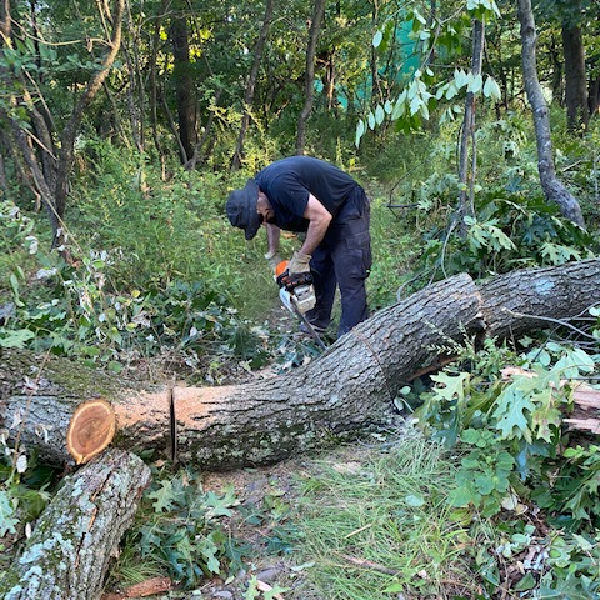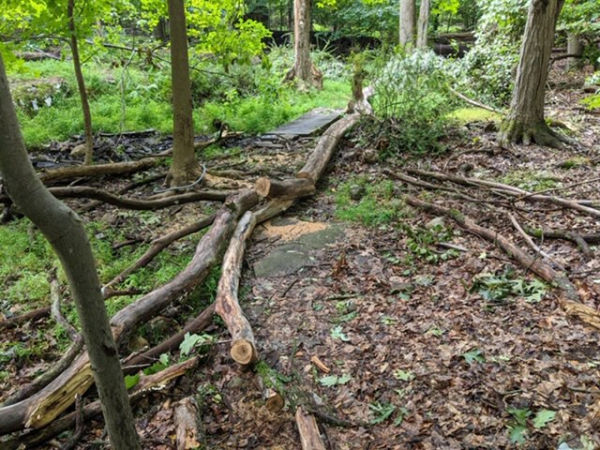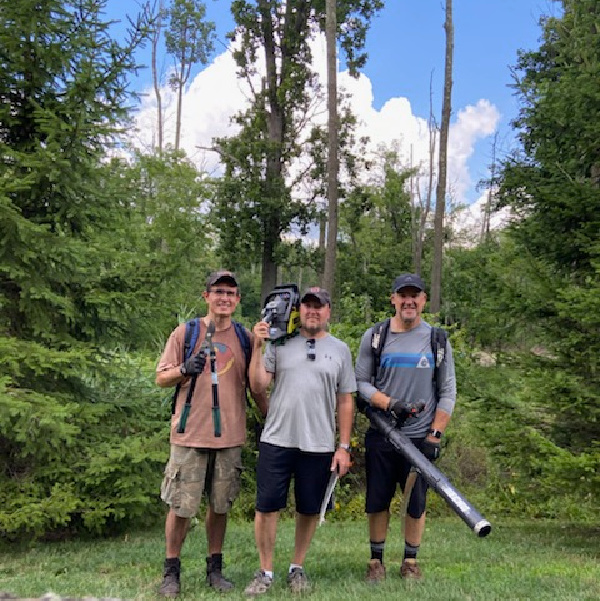
Isaias roared through Verona on August 4 and left a mark–in our yards and on the Hilltop Reservation trails that so many of us have been using for recreation during the pandemic. But while many of us were sweeping up leaves and calling insurance companies, tree services and roofing contractors, a team of volunteers went to the Hilltop to assess and repair the damage.
They found quite a lot, from sheared tree limbs on the ground to small, medium and large trees toppled and huge holes opened in the canopy. The quiet oasis on the hilltop became uninviting and off limits for visitors because every trail was blocked by huge, impassable blowdowns.
“Many of the fallen trees and limbs are likely as old or older than the oldest human residents here,” says Geordie Smith, one of the volunteers. Most of the volunteers are neighbors and local cyclists, who give back to protect the woodlands they enjoy and to ensure that the Hilltop is a safe experience for all visitors.

Without any central planning or coordination, the volunteers turned out with saws, blowers, rakes and determination, and put in more than 100 hours of effort to clear every trail and reopen the Hilltop. “There is something that sets these people apart and merits extra thanks and respect,” says Smith. “Nothing stopped any one else from doing some trail clearing themselves or stopping to help if they came across these volunteers hard at work,” he adds, “but regretfully plenty of people circumvented a blockage or looked the other way while the heavy work was done.”
Smith wants to make sure that people know that while nature can heal some of the damage done, it needs help for other repairs. “Trails are an added and not totally natural feature in a wild space,” he says. “Trails are routed and designed to be naturally compliant with the terrain, soil type, water flow, plant life, topography and even the sun. Accounting for all these considerations minimizes the impact that a trail could have on an environment and ensures that trails are built once without the need for maintenance despite ongoing usage.”
“While a downed tree blocking a trail may be a natural occurrence, the impact of an organic unplanned reroute around and over the blockage usually starts a cycle of damage,” Smith says. “An unplanned reroute tramples other plants and can upset less durable surfaces near trees, potentially upsetting a habitat and changing water flow, often for the worse. These factors all contribute to erosion thats lead to further trail wandering and widening and more impact on the natural environment.”
Smith encourages Hilltop visitors to pay careful attention to the trails on their next visit. “Notice the trail surface and its relationship to the surrounding woods, look for signs of water at work under your feet, and look for the newly cleared passages through fresh cut downed trees that reopens the blocked trails,” he says. “All that trail clearing by all those volunteers within a week of a damaging storm keeps trails where they were on a solid proven track that withstands all the natural forces that could act upon it.”
And Smith believes that everyone can help with trail maintenance, by doing simple things. “Bring a shopping bag sometimes to collect a carelessly discarded can, or bring small snips in later summer to trim back those overhanging spiky stems,” he says. “The Hilltop is for everyone to enjoy and everyone to take care of.”



Way to go to all the cyclists and others who volunteered their time to clean up the hilltop!